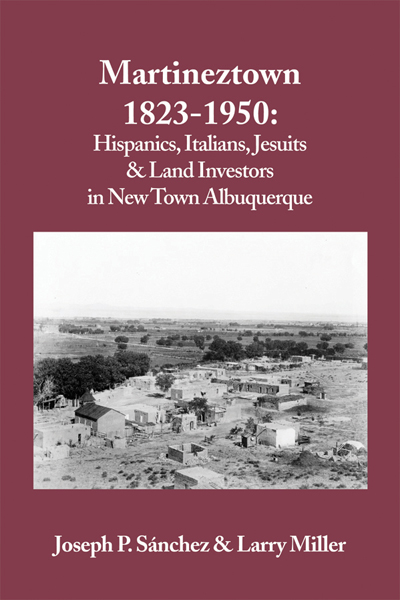Hispanics, Italians, Jesuits and Land Investors in New Town Albuquerque
by Joseph Sánchez & Larry Miller
2 photographs/4 maps - 228 pages
$17.95/PB (978-1-890689-44-5)
$32.95/HB (978-1-890689-53-7)

REVIEWS
An impressively researched study, ... I found the book both frustrating and interesting. The frustrating part is that one would have to have a good mental picture of the Martineztown neighborhood to be able to make sense out of the many property transactions which are listed . ... What was most interesting to me about the book was the way the authors were able to peel back so many layers of property development to the early beginnings of settlement; What has been regarded by many people as a lower-class blighted inner city area near the “Big I,” the interchange of Interstate Highways 40 & 25, is treated with respect for its history and inhabitants. The authors conclude their study by urging intelligent city planning not only to preserve the neighborhood but also to heal the wounds of the past. -- Reading New Mexico, March, 2009
For most modern day citizens of Albuquerque, Martineztown has always been a mysterious place. The histories of Albuquerque and large land grants that occupied the valley from Bernalillo to Isleta have long overshadowed the role of Martineztown in the development of the city. In the late Spanish Colonial period, settlers from Old Town and neighboring land grants used the pasturelands east of the plaza to graze their livestock. By the 1820s, the earliest landowners in what came to be known as Martineztown occupied properties there. Historical changes occurred after the acquisition of the Greater Southwest by the United States by dint of the Treaty of Guadalupe Hidaldgo in 1848 following the war with Mexico. The coming of the railroad in the 1880s, in particular, encouraged the development of Albuquerque’s New Town and lands east of Old Town. For nearly 100 years, from 1850-1950, Martineztown was at its zenith as a desireable place to invest.
Historically, little is known about Martineztown, save for a few reports in which brief histories of Martineztown are covered in a few paragraphs. The present study adds new historical perspectives of Martineztown by emphasizing, not its rich cultural history, but land tenure patterns that emerged from 1850 to 1950.
Certainly, Martineztown is deserving of a fuller history, for even though upstanding citizens invested in lands within the community, the Hispanic people who lived there were largely looked down upon socially and discriminated against politically and economically by the citizens of greater Albuquerque. By the 1960s, Martineztown was considered by city authorities to be a blighted area. The origins of such sentiments, which were at least ethnocentric and historical, resulted from a time when disdain for all things Mexican were common and vocal.
In the 1960s, Martineztown suffered through urban renewal and emerged as a checkerboarded area that is largely zoned as both commercial and residential. The history of land tenure in Martineztown follows a predictable pattern from 1850 to 1950.
Today, Martineztown is a place where old stigmas have disappeared but not forgotten. It is a place that represents diversity, more than any other part of Albuquerque. It is a place with a historical past that must be remembered and celebrated.